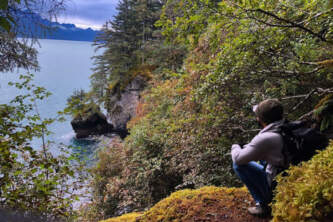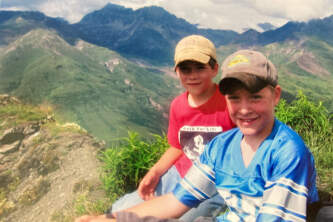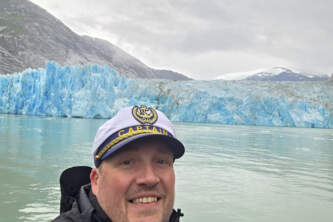By Debbie Jemison
We were heading into the final three days of our 10-day Alaska adventure. It had been an amazing journey highlighted by white-capped mountains, warm and friendly people, a welcoming culture, winding rivers tinted red with salmon, and even a close encounter with a mother moose gently nudging her young calf along a mottled wooded path. Little did we know that the highlight of our trip was yet to come. This Alaska vacation meant that I had finally meandered my way through all 50 states, yet still had not encountered a “whale in the wild.”
This Alaska vacation meant that I had finally meandered my way through all 50 states, yet still had not encountered a “whale in the wild.”
My husband, Bob, joked with our friends before we left that the only reason we were even going to Alaska was so that I could see whales. Because of that, we spent a long time dissecting itineraries in order to choose the perfect whale-watching/ wildlife-viewing tour. A Google search turns up dozens of choices, each with its own benefits — big boat vs. smaller boat, 4-hour duration vs. 7 or 8 hours, and, probably the most important criterion, which tour operator to sail with. We decided on the 8 1/2-hour excursion through Major Marine Tours leaving from Seward, figuring that the longer we were on the water, the better chance of seeing whales. It proved to be the perfect decision.
We arrived in Seward on July 25 and spent some time walking around the quaint town, taking selfies with the colorful murals and eating halibut and chips at the local Tap House. Later, while sitting on the deck outside our room at the Safari Lodge, we sipped a glass of wine and looked out at the pier, anxious and cautiously optimistic about what the next day’s ocean expedition might bring.
After a restful night, we set off for the tour boat, which was just a short walk from our room. It was a bit cloudy that day, but there was no rain, and the temperatures hovered in the upper 60s. Our boat was the smaller 32-person Viewfinder, the perfect size for maneuvering into areas that some of the larger boats couldn’t access. Captain Justin and First Mate Jack were second to none. They explained what we were seeing and what to watch for, answered our many questions about puffins and glaciers and worked hard to help us experience Alaska’s nature up close and personal.
We saw so many wonderful sights: sea otters diving off a floating island of ice, Stellar’s sea lions — did you know that they are larger than grizzlies!? — two kinds of puffins, the calving Northwestern Glacier, and even Kittlitz’s murrelet, an extremely rare seabird that lives only at the base of tidewater glaciers. Having traveled from central Illinois where we are surrounded by flatlands, corn and soybeans, the views in Kenai Fjords National Park and the Gulf of Alaska were absolutely jaw-dropping!
But the true scene-stealer was a group of 11 magnificent humpback whales. At first, they were off in the distance, and we couldn’t quite see what they were doing. Then they dove and re-appeared a little closer to the boat. We were fortunate enough to witness this behavior, what we later learned was called “cooperative bubble-net feeding,” four times before we heard Captain Justin yell, “I think they’re moving this way!”
We were fortunate enough to witness this behavior, what we later learned was called “cooperative bubble-net feeding,” four times before we heard Captain Justin yell, “I think they’re moving this way!”
By that time, we knew what to watch for. The first cue was that hundreds of seagulls began hovering over a concentrated area of the water, squawking excitedly in anticipation for what was to come. You could tell they had been through this drill before. Then, pure magic! The whales all burst through the surface of the water in an explosion with their huge mouths agape. The seagulls also got into the act, diving and quickly extracting fish just out of the reach of the feeding whales. All this activity took place just a few yards from where Bob and I were standing on deck, and we both were overcome with the natural beauty of these majestic creatures.
Bubble-net feeding is a learned behavior, so not all humpback whales know how to do it. In fact, it is estimated that only 10 - 20% of humpbacks have learned how to do it from their whale peers. Here is a simplistic explanation of what takes place: The humpbacks come to the surface and fill their lungs with air before swiftly diving to the bottom of the ocean. In this case, it was about a 350-foot dive. One of them — typically the matriarch — begins the process, and soon they all start swimming around in a circle and blowing bubbles as they go. This serves to confuse and entrap the fish.
The whales continue swirling and blowing bubbles as the matriarch then swims up from the bottom of the cyclone and, with a piercing whale call, frightens the fish even more. Then, as they barrel toward the surface, the whales all open their mouths while feeding on as many fish as possible. Efficient and ingenious! They do this over and over, capturing up to 5,000 pounds of krill each day while preparing to migrate to the warmer waters of Hawaii to breed. They only feed like this over the course of about 4 or 5 weeks a year, and they do not eat during the long migration and breeding period.
Later, after listening to the crew explain the behavior and looking it up online, we realized what an extremely rare experience this was and how blessed we were to observe it. I still tend to tear up when reliving our Alaska trip through photos and videos, including a really cool video of “our” humpbacks. In fact, simply reading this essay aloud to my husband today triggered an outpouring of emotions even now after several months. Our humpback whale moment was the highlight of our trip and definitely the experience of a lifetime.
The number one goal of our Alaska adventure was so I could see whales. Check that one off the list! What’s next? Only time will tell.
This story won the 2025 Alaska.org Story Contest prize for the category of "Wildlife Encounters"




